Covalent bonds
\[\require{mhchem}\]
Covalent bonds are formed between atoms by sharing electrons. In a covalent bond, the difference between the electronegativity of participating atoms is smaller than the ionic bonds. Covalent bonds are usually formed between elements within the \(p\) block. Atoms held together by covalent bonds give rise to molecular compounds.
Examples: \(\ce{H}_{2}\), \(\ce{HF}\) and \(\ce{H}_{2}\ce{O}\)

Atoms involved in a covalent bond acquire the octet in their valence shell by sharing electrons between atoms. Generally, the number of covalent bonds an atom forms depends on how many electrons an atom requires to achieve an octet. For instance, \(\ce{C}\) forms four covalent bonds as \(\ce{C}\) \(\left(1s^{2}2s^{2}2p^{2}\right)\) needs four more electrons to acquire an octet in their valence shell. A few more examples are listed in the following table.
| Element | Electron configuration | Electrons required to fill the octet | Number of covalent bonds |
|---|---|---|---|
| \(\ce{N}\) | \(1s^{2}2s^{2}2p^{3}\) | \(3\) | \(3\) |
| \(\ce{O}\) | \(1s^{2}2s^{2}2p^{4}\) | \(2\) | \(2\) |
| \(\ce{F}\) | \(1s^{2}2s^{2}2p^{5}\) | \(1\) | \(1\) |
| \(\ce{H}\) | \(1s^{1}\) | \(1\) | \(1\) |
However, the number of covalent bonds formed by an atom is not always guided by the octet rule. For instance, \(\ce{S}\) can form four or six covalent bonds such as \(\ce{SF}_{4}\) and \(\ce{SF}_{6}\). Some of the other exceptions to the octet rule are \(\ce{BF}_{3}\), \(\ce{PCl}_{5}\) and some of the \(p\) block elements in period four as they have empty \(d\) orbitals.
Multiple covalent bonds
Multiple covalent bonds are formed between two atoms when they share more than one pair of electrons to acquire valence shell octet. For instance, \(\ce{CO}_{2}\): \(\ce{C}\) forms two covalent bonds (2 pairs of electrons or 4 electrons) with each oxygen atom involved.

Ethyne is another example where carbon forms multiple bonds. In this case, one carbon atom forms a triple bond (6 electrons or 3 electron pairs) with another carbon atom to complete the octet.

Single bonds: when two electrons are shared between two atoms.
Double bonds: when four electrons are shared between two atoms.
Triple bonds: when six electrons are shared between two atoms.
Coordinate covalent bonds
When the shared electrons between two atoms are donated only by one atom, the resulting bond is known as a coordinate covalent bond. In a typical covalent bond, both atoms donate electrons to the bond. In contrast, in a coordinate covalent bond, an atom with a filled orbital shares its two electrons with an empty orbital of another atom.
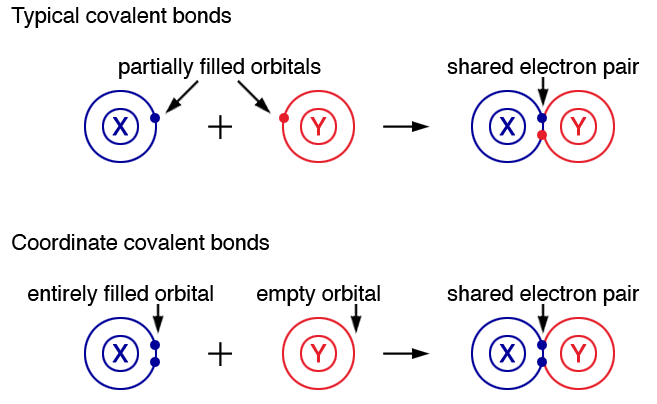
Examples: \(\ce{H}_{3}\ce{O}^{+}\) ion and \(\ce{NH}_{4}^{+}\) ion
Polar Covalent Bonds
Uneven sharing of two electrons creates a single covalent bond, but with a significant ionic component due to the difference in electronegativity, resulting in a distorted polarised molecular electron cloud. For instance, \(\ce{HF}\): \(\ce{H}\)’s EN - EN \(=\) electronegativity: ability of an atom in a molecule to attract electrons - is 2.20. \(\ce{F}\)’s EN is 3.98. The difference of EN \(=3.98-2.2=1.78\). Electrons are more strongly attracted to the more electronegative atom, in this case to \(\ce{F}\). So, the electron-rich \(\ce{F}\) has a partial negative charge (designated as \(\delta-\) ), while electron-poor \(\ce{H}\) has a partial positive charge \(\left(\delta+\right)\), creating a dipole moment \(\left(\mu\right)\). These types of bonds are known as polar covalent bonds.
The difference between the electronegativity of participating atoms in a bond indicates whether the bond is ionic, covalent or polar covalent.
| Electronegativity difference | Type of bond | Examples |
|---|---|---|
| \(\geqslant2.0\) | Ionic | \(\ce{NaCl}\), \(\ce{CsF}\) |
| \(0.5-1.9\) | Polar covalent | \(\ce{HCl}\), \(\ce{H}_{2}\ce{O}\) |
| \(0-0.4\) | Covalent | \(\ce{CH}_{4}\), \(\ce{O}_{2}\) |
The Polarity of Molecules
The net polarity of a molecule depends on the polarity of the individual bonds, the contribution from lone pairs, and the molecule’s shape. In a polar molecule, electrons are more strongly attracted to one part of the molecule. For example, in the water molecule, due to the high electronegativity of the oxygen atom, electrons are strongly attracted towards the oxygen atom creating the net polarity point between two \(\ce{O}-\ce{H}\) bonds.
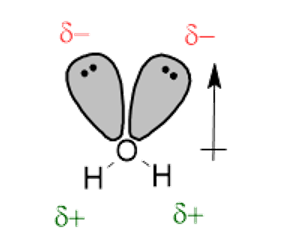
In some cases, although the individual covalent bonds are polar, overall the molecule becomes non-polar due to the shape of the molecule. For instance, a carbon dioxide molecule has polar \(\ce{C}-\ce{O}\) bonds. However, due to the linear symmetrical shape of the molecule, polar bonds (dipoles) cancel each other, creating a zero net polarity.

Naming Binary Molecular Compounds
-
The name of the less electronegative atom is written first, followed by the more electronegative atom. Therefore, metals come before nonmetals, and nonmetals located on the left side of the periodic table are written before nonmetals located on the right side.
-
The name of the more electronegative atom should end with the suffix -ide as used for anions.
-
Depending on the number of atoms of each element involved in the compound, prefixes such as di, tri, tetra, penta etc. may apply. For instance, compound \(\ce{CCl}_{4}\) is named as “Carbon tetrachloride”.
Examples
| Molecular formula | Name of the compound |
|---|---|
| \(\ce{CO}\) | Carbon monoxide |
| \(\ce{CO}_{2}\) | Carbon dioxide |
| \(\ce{BBr}_{3}\) | Boron tribromide |
| \(\ce{N}_{2}\ce{O}_{5}\) | Dinitrogen pentoxide |
Valence Shell Electron Pair Repulsion Theory (VSEPR theory)
VSEPR theory states that the shape of a molecule is determined by the number of electron clouds around the central atom. Lone pairs and bonded valence electrons are considered electron clouds. Due to the repulsion forces between electron clouds, they attempt to stay as far as possible. For instance, a carbon dioxide molecule has two electron clouds (two \(\ce{C}-\ce{O}\) bonds) around the central atom \(\ce{C}\). As a result of repulsion forces between these two electron clouds, the molecule is arranged into linear geometry with a bond angle of \(180^{\circ}\). Multiple bonds such as double and triple bonds are considered one electron cloud.
Steps to determine the shape of a molecule using VSEPR theory:
- Draw the Lewis structure of the molecule and identify the central atom.
For instance, in an ammonia molecule (\(\ce{NH}_{3})\), the central atom is \(\ce{N}\) as it forms most bonds.
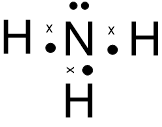
- Sum up the number of bonds and lone pairs connected to the central atom to get the total number of electron clouds around the central atom.
Example: In the ammonia molecule, the central atom \(\ce{N}\) has three bonds with each \(\ce{H}\) atom and one lone pair. Therefore there are four electron clouds (three bonds and one lone pair) around the central atom.
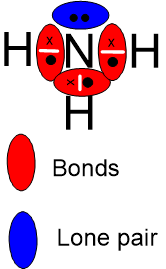
- Anticipate the shape of the molecule based on the number of electron clouds around the central atom.
Example: Four electron clouds around \(\ce{N}\) arrange in such a way that each cloud stays as far as possible from the others to minimise the repulsion forces between them. Generally, when there are four electron clouds around the central atom, these are arranged to result in a tetrahedral shape. A tetrahedron is composed of four equilateral triangles. The central atom is located in the centre and electron clouds are located towards the corners of the tetrahedron. Molecules with a tetrahedral shape have a bond angle of \(109^{\circ}\). Due to the presence of a lone pair on one corner of the tetrahedron, the overall shape of ammonia becomes pyramidal rather than tetrahedral with a bond angle of \(107^{\circ}\).

| Number of bonds | Number of lone pairs | Total number of electron clouds | Shape | Example |
|---|---|---|---|---|
| 2 | 0 | 2 | Linear | 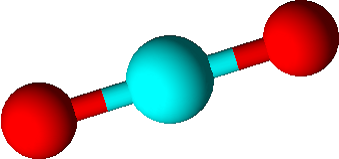 |
| 3 | 0 | 3 | Trigonal planar | 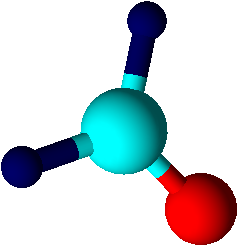 |
| 2 | 1 | 3 | Angular/bent | 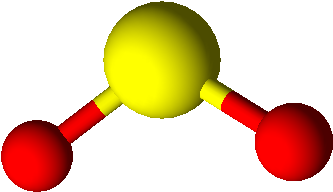 |
| 4 | 0 | 4 | Tetrahedal | 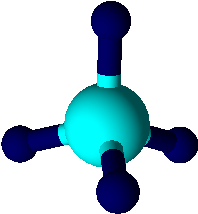 |
| 3 | 1 | 4 | Pyramid | 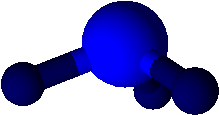 |
| 2 | 2 | 4 | Angular/bent |  |
When more than one central atom is present in the molecule, predict the molecular geometry of each central atom and then combine the results. For instance, \(\ce{C}_{2}\ce{H}_{4}\) has two central \(\ce{C}\) atoms. Each \(\ce{C}\) atom is attached to three electron clouds. This means each \(\ce{C}\) atom has a trigonal planar geometry. In this case, the whole molecule is also planar, as the bond angles \(\ce{H}-\ce{C}-\ce{H}\) and \(\ce{H}-\ce{C}-\ce{C}\) are \(120^{\circ}\) each.

